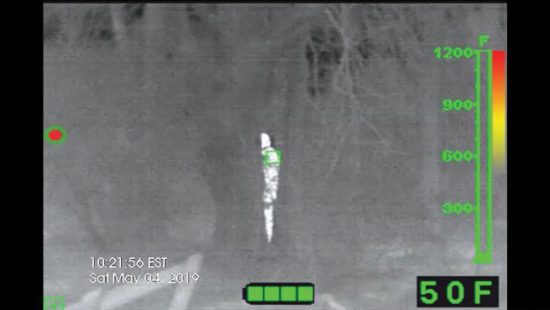
Thermal imagers and cold weather
By Manfred Kihn
Features Equipment firefighter firefighter training First Responders Thermal imager in action for a ground search and rescue operation.
Thermal imager in action for a ground search and rescue operation. In your part of the country, you may already be experiencing adverse weather conditions and perhaps even have some snow. The use of a thermal imager (TI) in cold weather emergencies can be extremely beneficial for fire fighting and rescue operations. Thermal imagers detect and display infrared radiation, which allows firefighters to visualize heat signatures and temperature differences. In cold weather situations, these devices can play a crucial role in improving situational awareness and enhancing operational effectiveness. Here’s how thermal imagers can be used in cold weather emergencies.
Locating victims: In cold weather emergencies, such as snowstorms or freezing temperatures, victims may become hypothermic when they get lost. Thermal imagers may help locate individuals by detecting their body heat signatures and can be used for a quick patient assessment to help determine if there is frostbite and/or hypothermia. A quick scan of the victim’s face, arms, fingers, legs and feet can show the affected areas. The basic colourization in a thermal imager is: white is hot, black is cold and everything else in between are shades of gray. So, using a TI to check for cold extremities will show up as darker or black. This is valuable information to relay to the medics or hospital staff for appropriate treatment.
Search and rescue: When responding to accidents in remote, cold environments, thermal imagers aid in searching for survivors by identifying their body heat against the cold background. This can speed up search and rescue efforts and increase the chances of locating people quickly such as lost or missing snowmobilers, injured downhill and cross-country skiers, etc. Understand that detection of infrared cannot penetrate through any thickness of snow, so in areas that are affected by avalanche conditions, a thermal imager will not be effective. Image contrast is a factor that needs to be taken into consideration as the colder temperature will provide a better definition due to the greater initial thermal differential with warmer objects. Footprints in the snow can be seen for a long time with the use of a TI. Even though we are not tracking any sort of heat signature, the footprints are detected due to the disturbance in the snow’s emissivity.
The integration of thermal imaging technology into cold weather emergency response can enhance the safety of responders.
Advertisement
Fire fighting: Thermal imagers are used by firefighters to detect hidden fires and hotspots, even in cold conditions. They can identify sources of heat within structures that might otherwise be hard to locate due to the presence of snow or ice. This capability can prevent fires from reigniting or spreading.
Structural assessments: In cold weather, the performance of buildings and structures can be affected by temperature changes and freezing conditions. Thermal imagers can help assess the structural integrity of buildings by identifying areas with different heat patterns, leaks or other anomalies. Extreme ice buildup may indicate weaknesses with potential for collapse.
Monitoring equipment: Cold weather can impact the functionality of machinery and equipment, leading to overheating or freezing. Firefighters can use thermal imagers to monitor the temperature of equipment and mechanical systems to prevent failures and maintain operational readiness.
Vehicle accidents: Thermal imagers can aid in locating and identifying occupants of vehicles involved in accidents, especially if they are trapped, injured, or ejected and unable to communicate their location.
Hazmat situations: In cold weather emergencies involving hazardous materials, thermal imagers can help detect leaks or spills by identifying temperature differences caused by the release of these substances.
Image degradation: When it is raining, foggy or snowing, image degradation can occur because the water particulates absorb the infrared before it reaches the TI, giving you are very grainy image on the display. There is nothing wrong with your TI, just remember that there are visual limitations using a TI and this occurrence can be one of them.
To effectively use thermal imagers in cold weather emergencies, it’s important for fire service personnel to receive proper training in their operation and interpretation. Additionally, maintaining the equipment’s battery life and protecting it from extreme cold is crucial to ensure the thermal imager’s functionality during critical operations. If you are outside for an extended period of time, perhaps on a victim search and rescue, keep your spare batteries on the charger or as warm as possible like in your inner pocket.(Photo courtesy of Bullard – footprints in the snow which has disturbed the emissivity)
Overall, the integration of thermal imaging technology into cold weather emergency response can enhance the safety of responders, increase the efficiency of operations, and improve the chances of successful outcomes in challenging environments.
Until next time stay safe and train often.
Manfred Kihn is a 19-year veteran of the fire service. He is Bullard’s fire training specialist for thermal imaging technology. He is certified through the Law Enforcement Thermographers’ Association as a thermal imaging instructor and is a recipient of the Ontario Medal for Firefighters Bravery. You can e-mail him at manfred_kihn@bullard.com.
Print this page
Advertisement
- More than 100 wildfires still not considered out after B.C.’s record wildfire season
- Saskatoon firefighters battling difficult conditions at industrial fire